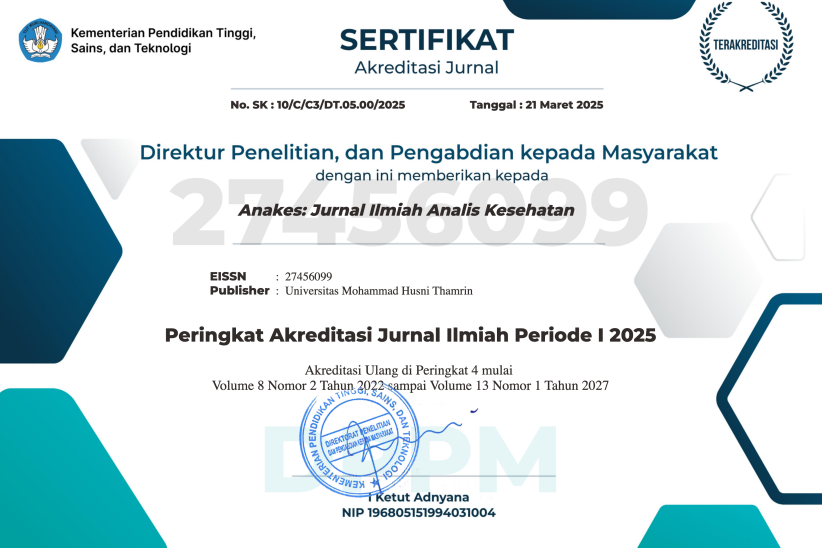Deteksi Dini Hipertensi Menggunakan Cold Pressure Test Pada Mahasiswa Fakultas Kedokteran Universitas Gunadarma Tahun 2025
DOI:
https://doi.org/10.37012/anakes.v11i1.2653Abstract
Hypertension is one of the major non-communicable diseases (NCDs) that causes serious damage to blood vessels and vital organs such as the heart, kidneys, and brain. The Indonesian Health Survey reported that the prevalence of hypertension among adolescents aged 15–24 years reached 9.3%. According to the Basic Priority Rating (BPR) from the Depok City Health Office, hypertension ranks as the top NCD priority with a score of 38.69%. Early detection is essential to prevent delays in diagnosis and treatment. One method that can be used for early detection of hypertension in adolescents is the Cold Pressure Test (CPT). This study aimed to determine changes in systolic and diastolic blood pressure using the CPT method. This was an observational study with a cross-sectional design involving 43 medical students as participants. Blood pressure was measured at three stages: before hand immersion in ice water, after 30 seconds, and after 60 seconds. Data were analyzed using the Friedman test to assess differences across the three measurements. The results showed that systolic blood pressure increased from 117.35 mmHg to 132.12 mmHg at 60 seconds, while diastolic blood pressure increased from 79.07 mmHg to 88.74 mmHg. Statistical analysis revealed a p-value of 0.001 (< 0.005) for both systolic and diastolic pressure. The study concluded that there was a significant increase in systolic and diastolic blood pressure after the CPT. This indicates that adolescent blood pressure is reactive to cold stimuli, and CPT may serve as an effective method for early detection of hypertension.
Keywords: Cold Pressure Test, Hypertension, Blood Pressure, Pukse
Downloads
Published
How to Cite
Issue
Section
Citation Check
License
Copyright (c) 2025 Sri Rahayu Ningsih, Rafi Abraar Sadewa, Srimukti Suhartini, Danurwendo Sudomo

This work is licensed under a Creative Commons Attribution 4.0 International License.
Anakes :Â Jurnal Ilmiah Analis Kesehatan allows readers to read, download, copy, distribute, print, search, or link to the full texts of its articles and allow readers to use them for any other lawful purpose. The journal allows the author(s) to hold the copyright without restrictions. Finally, the journal allows the author(s) to retain publishing rights without restrictions Authors are allowed to archive their submitted article in an open access repository Authors are allowed to archive the final published article in an open access repository with an acknowledgment of its initial publication in this journal.

Lisensi Creative Commons Atribusi 4.0 Internasional.











